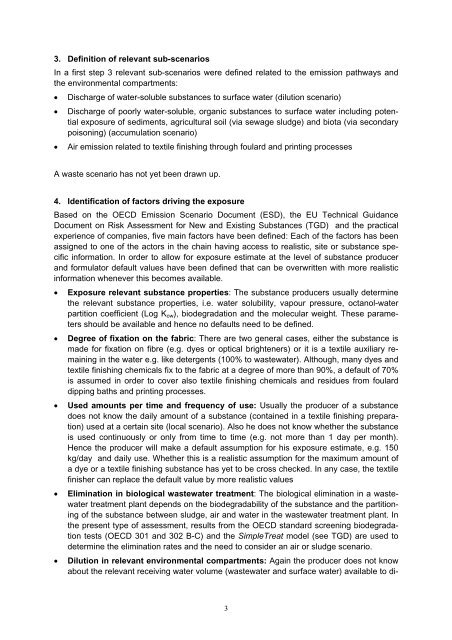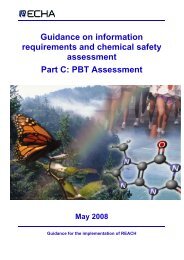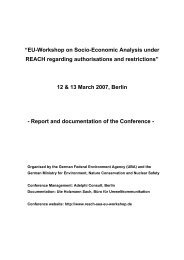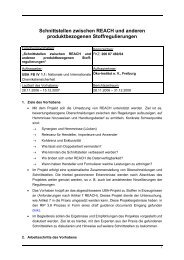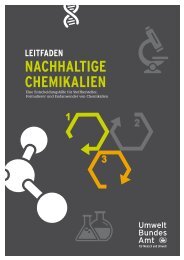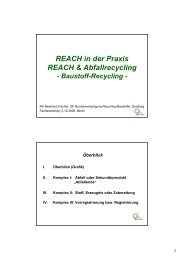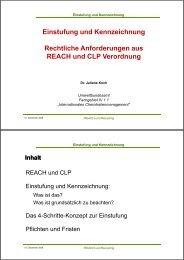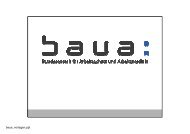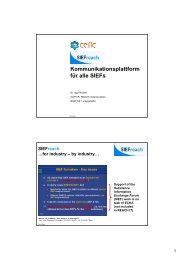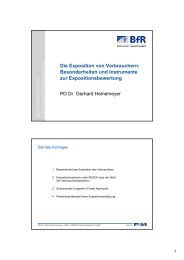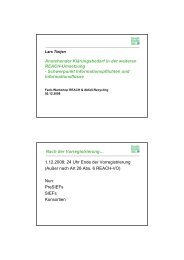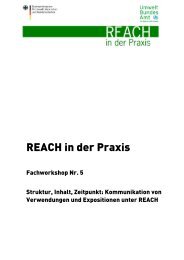Schlussbericht 2004-11-30 - REACh
Schlussbericht 2004-11-30 - REACh
Schlussbericht 2004-11-30 - REACh
Sie wollen auch ein ePaper? Erhöhen Sie die Reichweite Ihrer Titel.
YUMPU macht aus Druck-PDFs automatisch weboptimierte ePaper, die Google liebt.
3. Definition of relevant sub-scenarios<br />
In a first step 3 relevant sub-scenarios were defined related to the emission pathways and<br />
the environmental compartments:<br />
• Discharge of water-soluble substances to surface water (dilution scenario)<br />
• Discharge of poorly water-soluble, organic substances to surface water including potential<br />
exposure of sediments, agricultural soil (via sewage sludge) and biota (via secondary<br />
poisoning) (accumulation scenario)<br />
• Air emission related to textile finishing through foulard and printing processes<br />
A waste scenario has not yet been drawn up.<br />
4. Identification of factors driving the exposure<br />
Based on the OECD Emission Scenario Document (ESD), the EU Technical Guidance<br />
Document on Risk Assessment for New and Existing Substances (TGD) and the practical<br />
experience of companies, five main factors have been defined: Each of the factors has been<br />
assigned to one of the actors in the chain having access to realistic, site or substance specific<br />
information. In order to allow for exposure estimate at the level of substance producer<br />
and formulator default values have been defined that can be overwritten with more realistic<br />
information whenever this becomes available.<br />
• Exposure relevant substance properties: The substance producers usually determine<br />
the relevant substance properties, i.e. water solubility, vapour pressure, octanol-water<br />
partition coefficient (Log Kow), biodegradation and the molecular weight. These parameters<br />
should be available and hence no defaults need to be defined.<br />
• Degree of fixation on the fabric: There are two general cases, either the substance is<br />
made for fixation on fibre (e.g. dyes or optical brighteners) or it is a textile auxiliary remaining<br />
in the water e.g. like detergents (100% to wastewater). Although, many dyes and<br />
textile finishing chemicals fix to the fabric at a degree of more than 90%, a default of 70%<br />
is assumed in order to cover also textile finishing chemicals and residues from foulard<br />
dipping baths and printing processes.<br />
• Used amounts per time and frequency of use: Usually the producer of a substance<br />
does not know the daily amount of a substance (contained in a textile finishing preparation)<br />
used at a certain site (local scenario). Also he does not know whether the substance<br />
is used continuously or only from time to time (e.g. not more than 1 day per month).<br />
Hence the producer will make a default assumption for his exposure estimate, e.g. 150<br />
kg/day and daily use. Whether this is a realistic assumption for the maximum amount of<br />
a dye or a textile finishing substance has yet to be cross checked. In any case, the textile<br />
finisher can replace the default value by more realistic values<br />
• Elimination in biological wastewater treatment: The biological elimination in a wastewater<br />
treatment plant depends on the biodegradability of the substance and the partitioning<br />
of the substance between sludge, air and water in the wastewater treatment plant. In<br />
the present type of assessment, results from the OECD standard screening biodegradation<br />
tests (OECD <strong>30</strong>1 and <strong>30</strong>2 B-C) and the SimpleTreat model (see TGD) are used to<br />
determine the elimination rates and the need to consider an air or sludge scenario.<br />
• Dilution in relevant environmental compartments: Again the producer does not know<br />
about the relevant receiving water volume (wastewater and surface water) available to di-<br />
3


